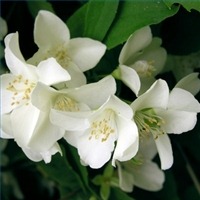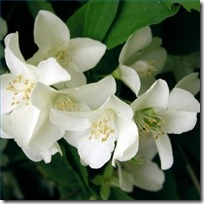Jasmine (Jasminum spp.) is a perennial plant and a member of the Oleaceae family. This plant is well known for its strong fragrance; an entire garden can be perfumed by a single vine of jasmine. Not only is this jasmine used as an ornamental plant for its showy flowers, but it is also cultivated for a variety of other uses.
- Common White Jasmine and Winter Jasmine are the most commonly cultivated types of jasmine. Other types of jasmine include Showy Jasmine, South African Jasmine, Spanish Jasmine, Italian Jasmine, Primrose Jasmine and Downy Jasmine. Confederate Jasmine and Star Jasmine aren’t actually jasmine at all, but a member of the Trachelospermum family.
Common White Jasmine
- Common white jasmine (Jasminum officinale), also known as poet’s jasmine, matures to a height of 10 to 15 feet. This plant can grow either as a shrub or a vine. When used as a vine, this plant requires support by a trellis or fence. The flowers produced by this common type of jasmine measure an inch in diameter and bloom throughout the summer and fall. This plant grows anywhere from 12 to 24 inches annually when planted in full sun or partial shade in warm climates.
Winter Jasmine
- Winter Jasmine (J. nudiflorum) was commonly found surrounding homes during the Victorian era and grows 4 feet high as a shrub or 15 feet tall as a vine. This vine spreads quickly and requires periodic pruning. The yellow flowers of this plant bloom in the late winter and early spring but are not fragrant. Winter Jasmine is commonly used to cover trellises and fences because of the showy flowers it provides.
Jasmine Flower Oil
- The flowers produced by the common white jasmine produce an oil that is widely cultivated for use in a variety of products, including perfume, cosmetics, cream, soap, oils and shampoo. The oil produced by this plant is comprised of benzyl acetate, terpineol, jasmone, benzyl benzoate and many types of alcohol.
Other Uses
- Roots and leaves of the jasmine plant are also commonly used for medicinal purposes. Jasmine has been used as an aphrodisiac, and historically utilized as an alternative treatment for tapeworm and ringworm. Arabian Jasmine has antimicrobial benefits and is used to flavor teas.


Deprecated: strpos(): Passing null to parameter #1 ($haystack) of type string is deprecated in /home/agriviek8Qv/agriviet.net/public_html/wp-includes/comment-template.php on line 2522